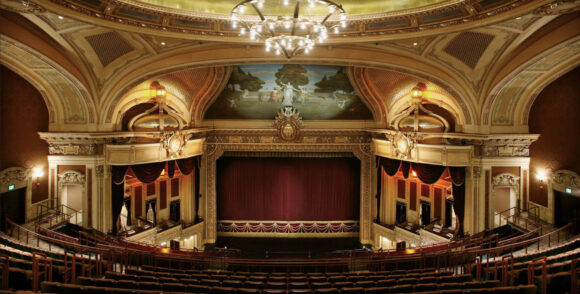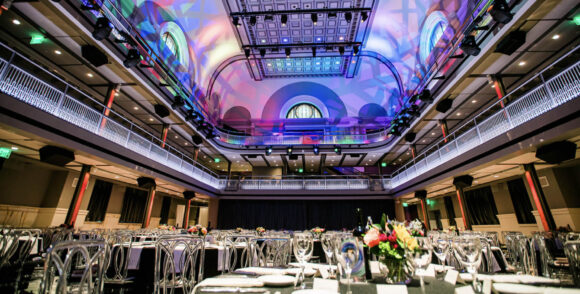
Our History

1914 – 1920
Early History of the Hippodrome Theater
Built in 1914, the Hippodrome Theatre was designed by Thomas W. Lamb, the pre-eminent theater architect of the time.
It was an important transitional project in the career of Mr. Lamb. Born in Scotland, and without formal architectural training, Lamb began practicing architecture in 1892 after an apprenticeship as a building inspector, which involved him in the practical considerations of theater construction. By the time he was working on the Hippodrome, Lamb had established a reputation as one of the nation’s leading theater architects. He designed more than 300 vaudeville theaters and movie palaces worldwide with his longtime collaborator, Marcus Loew. At least 12 of Lamb’s theaters are listed on the National Register of Historic places. His heralded work abroad includes theaters in England, Australia, North Africa, India and Egypt.
Although much of Lamb’s work reflected a simpler style, the Hippodrome Theatre represents one of the last opulent designs from his early period and is an outstanding example of early 20th century theater design. A richly textured, sculptural façade of ornamental brickwork framed three arches, and a magnificent terracotta frieze and cornice crowned the building. The lavishly decorated and dynamic interior, originally a palette of creams, tans and brown accented in silver and gold, focused on the elaborate proscenium arch and stage. Above the proscenium arch, Vincent Maragliotti’s richly colored allegorical painting survived despite extensive damage from water and age. Painted in 1914, the mural is one of the hallmarks of the theater. It is 26 feet high and 45 feet wide at the base, and forms an unusual, truncated bell curve. The composition is an allegory featuring goddesses from Greek mythology which might appropriately be called, “The Triumph of the Performing Arts.” The central figure of Athena (goddess of the arts) is flanked by Clio (muse of history) and Terpsichore (muse of lyric poetry and dance) on either side and Thalia (muse of comedy) and Melpomene (muse of tragedy) on the extreme right and left, respectively. Page Conservation, Inc. of Washington, D.C., recommended that the mural be repaired. As part of the renovation before the theater reopened in 2004, the mural received conservation treatment from Conrad Schmidt Studios, Inc. of New Berlin, Wisconsin.
Billed as “the largest theater south of Philadelphia” when it opened, the Hippodrome Theatre quickly became the most fashionable place in town. Loew’s operated the theater featuring live vaudeville; it was an integral part of the west side, Baltimore’s vibrant entertainment district. The Iron Master was the first film to be shown at the theater in November 1914. A two-reel movie, it was accompanied by seven vaudeville acts. A typical vaudeville program from 1915 included an orchestra performance followed by trapeze performers, “Thompson’s Elephants,” “Barlow’s Dogs and Ponies,” “Webb’s Seal’s,” and “Arizona Days” featuring America’s greatest cowgirl rider, Adel Von Ohl. The list of noted figures who performed at the Hippodrome ranged from vaudeville stars such as the flamboyant Sophie Tucker, to stage actress Ethel Barrymore, comedian Red Skelton, the multi-talented entertainer Danny Kaye, and bandleaders Cab Calloway, Glenn Miller, Guy Lombardo, and the “King of Swing” Benny Goodman. Frank Sinatra made his solo debut performance with the Harry James Orchestra on June 30, 1939. Flight to Mars and The Highwayman, both released in December 1951, marked the end of vaudeville-style shows that combined live performances with movies, paving the way for double movie bills. In November 1967, Gone with the Wind played at the Hippodrome Theatre but, due to a one-alarm fire, the show was cut short and patrons had to be evacuated. Up in Smoke in 1978 was the last film to be shown at the Hippodrome Theatre.
The Hippodrome Theatre also played an important part in Baltimore entertainment history in 1917 when it became the first theater in Baltimore City to show motion pictures. Designed to host vaudeville shows as well as the new moving picture technology, the Hippodrome Theatre was one of the earliest dual-purpose theaters in the country. By 1920, the Hippodrome and two nearby theaters were drawing 30,000 patrons per week to three daily performances.

1960 – 1990
The Decline
By 1960, the Hippodrome was beginning to show its age, with a shrinking audience and gradual disintegration of the surrounding neighborhood.
After almost thirty years, Morton Rappaport was beginning to withdraw from actively managing the Hippodrome Theatre. The theater was leased for a twenty-year period to the Trans-Lux Corporation, a major chain of east coast motion picture theaters.
Trans-Lux spent a reported $150,000 renovating the theater. The Rappaport era marquee was replaced with a much smaller stainless-steel version. The large vertical Hippodrome sign that had been there from the opening of the theater in 1914 was also discarded. By the late 1970’s the frieze and cornice at the top of the building were weak and were removed rather than reinforced. These changes greatly altered the appearance of the façade of the theater. Drastic changes were also made inside the theater. To fight the competition from television, Hollywood began experimenting with a variety of wide-screen techniques like Vista vision and Cinerama. This technology required wide, curved screens stretching across the front of the theater. To accommodate this equipment, the proscenium boxes and their canopies were removed from either side of the screen. Sometime during the 70’s, the crystal chandelier that was hanging above the orchestra disappeared and was never replaced. The elaborate stenciling and gold leaf on the ceiling was covered with grey paint. Many other theaters were renovated during this decade as well. The popular method for decorating the walls was to cover them with fabric. Pink polyester fabric was hung from floor to ceiling, even covering the mural above the stage.
The new theater decoration did not look anything like the theater Baltimoreans had come to love. Even though the theater was big, with the new design, patrons said it felt claustrophobic. One critic even described the effect as “sitting in a coffin.”
In the spring of 1968, after the assassination of Martin Luther King, Baltimore experienced inner city riots that affected many cities across the country. By this time, only three downtown film theaters remained open, and their continued operation was uncertain. The Hippodrome Theatre, in an effort to adapt to new audiences, began to show blaxploitation and kung fu films. The showing of violent films was a survival technique that characterized the theater as a “grind house.” Nonetheless, the Hippodrome Theatre remained open for two more decades.
By 1990, all audiences had dried up, and an August edition of The Sun headlined: “Hippodrome Closed Forever.” Fortunately, this was not the case.
Continental Realty, the company that owned the theater in 1990, was unsuccessful in its efforts to rent or sell the building. No one was even interested in tearing it down. The company did not consider it economically viable for them to either maintain or renovate the theater, or even to redevelop it for other purposes. Because of this, Continental Realty made the decision to donate the Hippodrome Theatre to its neighbor: the University of Maryland, Baltimore.
The Eutaw/Howard Street corridor had been Baltimore’s central shopping and theater district since the early part of the twentieth century. Unfortunately, by the close of the 1990’s, all of this activity had migrated to the suburbs. Baltimore’s West Side was deserted and empty compared to earlier decades. But thankfully, that would change in the new century.
1991 – 2003
Turn of the Century
Leaders agreed in the late 1990s that if Baltimore was going to attract National Broadway Tours, a new performing arts center was needed.
University of Maryland, Baltimore (UMB) owned the Hippodrome Theatre in the late 1990s at the time when a study was being conducted about where Broadway in Maryland should be headquartered. Baltimore and Maryland leaders decided that renovating the Hippodrome Theatre was in the best interest of our community, so UMB sold the building to the Maryland Stadium Authority for $1 in 2000.
There was excitement about creating an “anchor” that would attract business to the west side of Baltimore. The renovation would include the absorption of three adjacent buildings: The Eutaw Savings Bank, the Western National Bank and a candy store south of the Hippodrome Theatre. As part of this first Hippodrome Project, three of the four buildings were renovated. The northern-most building of the complex was never finished.
All at University of Maryland, Baltimore are proud of our legacy and connection that we share with the Hippodrome Foundation. We are fortunate to have the France-Merrick Performing Arts Center as our neighbor and look forward to maintaining a close partnership in the years to come.
Bruce Jarrell
President, University of Maryland, Baltimore
2004 – Present
Recent History of the Hippodrome Theater
The Hippodrome Theatre had been abandoned for ten years. HFI worked with the Maryland Stadium Authority and led a $70+ million capital campaign to create a brand-new performing arts center within the block bordered by Fayette, Eutaw, Paca and Baltimore Streets. The new France-Merrick Performing Arts Center reopened on February 10, 2004 with Mel Brooks’ The Producers.
The spectacular new Hippodrome Theatre solved a problem Baltimore had been facing: the economics of Broadway were such that Baltimore was not going to get shows at the Morris A. Mechanic Theater. That theater had too few seats to make it “worth it” for producers to bring shows to Baltimore. With more than 2000 seats and a state-of-the-art new theater, the Hippodrome Theatre provided a professional space to welcome the biggest and most popular shows (e.g., Disney’s The Lion King, Phantom of the Opera, Wicked, etc.). Over the years, the France-Merrick Performing Arts Center has entertained millions of patrons and contributed hundreds of millions in economic impact to Baltimore City and the State of Maryland.
In 2016, the HFI Board decided it was time to activate the northern-most building—the building that had not been renovated in the earlier project. HFI commissioned a feasibility study to determine best use of the space for our Baltimore community. Experts advised the best possible use would be to transform the space into a state-of-the-art flexible event space that would accommodate 600, used for both affordable entertainment and HFI outreach programs. Designs were completed by famed architect Gary Martinez and in 2018, the HFI Board announced a capital campaign to raise the needed $12 million. Unfortunately, efforts to raise funding were interrupted when the world was shut down by the COVID pandemic. HFI’s capital campaign was suspended for a year and then resumed with a higher target due to escalations in cost caused by the pandemic. The state was a major part of this success story. Groundbreaking for the new “M&T Bank Exchange” happened on December 6, 2021, with a certificate of occupancy awarded in August of 2023. True to the feasibility study, the M&T Bank Exchange is an active community events facility that serves diverse organizations. The future of Baltimore’s performing arts center is brighter with the addition of the M&T Bank Exchange.
The dedication of the HFI Board, and important partnerships with UMB, the Maryland Stadium Authority and the John Gore Organization have resulted in creating and operating one of the country’s most stunning performing arts centers. Our foundation is committed to maintaining, protecting and sharing the assets of this state facility. We remain grateful to the many partners who made this center possible.
